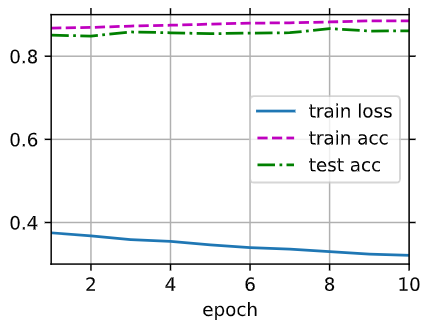一、前言
1、和softmax实现一样,唯一的区别是我们模型含有两个全连接层
2、直接通过高级API更简洁实现多层感知机
3、对于相同的分类问题,多层感知机的实现和softmax回归的实现完全相同,只是多层感知机的实现增加了带有激活函数的隐藏层
二、模型
1、第一层是隐藏层,包含256个隐藏单元,并使用ReLU激活函数
2、第二层是输出层
# 因为图片是一个3D的东西,然后使用nn.Flatten()为二维
# nn.Linear(784, 256)线性层,输入为784,输出为256
# nn.Linear(256, 10)线性层,输入为256,输出为10
net = nn.Sequential(nn.Flatten(), nn.Linear(784, 256), nn.ReLU(),
nn.Linear(256, 10))
def init_weights(m):
if type(m) == nn.Linear:
#从给定均值和标准差的正态分布(mean, std)中生成值,填充输入的张量或变量
nn.init.normal_(m.weight, std=0.01)
# net.apply:会先遍历子线性层,再遍历父线性层
net.apply(init_weights);
三、训练过程
# num_epochs:表示跑多少轮 batch_size, lr, num_epochs = 256, 0.1, 10 loss = nn.CrossEntropyLoss()# 损失函数 # 更新数据 trainer = torch.optim.SGD(net.parameters(), lr=lr)
# 下载测试数据集和训练数据集 train_iter, test_iter = d2l.load_data_fashion_mnist(batch_size) # 直接调用d2l包的train_ch3函数 d2l.train_ch3(net, train_iter, test_iter, loss, num_epochs, trainer)
